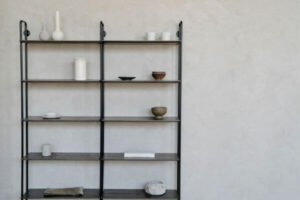In the realm of interior design, particularly within compact living spaces, the thoughtful utilization of vertical space emerges as a pivotal strategy. While efficient storage solutions remain paramount, the incorporation of well-designed shelves and bookshelves serves a dual purpose by transforming walls into prominent elements within the overall design. In this comprehensive exploration, we will delve deeper into the nuanced facets of vertical space optimization, showcasing how shelves and bookshelves can captivate both functionally and aesthetically, providing a harmonious blend of style and practicality in spaces of varying sizes.
1. Embracing Verticality as a Core Design Element
The concept of verticality extends beyond mere functionality, evolving into a core design element. Shelves and bookshelves that ingeniously exploit the height of walls contribute to the creation of an expansive visual narrative. This intentional design choice imparts an illusion of heightened ceilings, establishing an ambiance of openness and spaciousness. Opting for pieces that extend seamlessly from the floor to the ceiling not only amplifies storage capacity but also introduces a commanding architectural element.
Creative Tip: Consider a vertical bookshelf installation in the living room that spans the full height of the wall, offering not only a repository for books and decorative items but also an arresting visual focal point.
2. The Airiness of Suspended Design
Suspended shelves and bookshelves exemplify a design strategy that transcends mere practicality, introducing an element of visual lightness. Elevating the structure above the floor not only creates a sense of floating elegance but also imparts an airy quality to the room. This approach proves particularly impactful in smaller spaces, where reducing the visual clutter on the floor contributes significantly to the perception of expansiveness.
Creative Tip: Implement a suspended shelf in the kitchen, providing not just a functional space for utensils but also cultivating a modern atmosphere and facilitating easy floor maintenance.
3. Modular Flexibility for Dynamic Environments
The ethos of modern living often necessitates adaptability, and modular shelves and adjustable bookshelves emerge as stalwart companions in this dynamic landscape. The ability to effortlessly rearrange shelves to accommodate diverse objects of varying sizes fosters an environment of flexibility. This versatility is paramount, especially in spaces that undergo frequent transformations in response to shifting decor or functional requirements.
Creative Tip: Integrate a modular bookshelf in the home office, allowing for the dynamic arrangement of books, electronic gadgets, and decorative pieces, catering to the evolving demands of the space.
4. Harmonizing Functionality and Style
Beyond their utilitarian roles, shelves and bookshelves possess the potential to become pivotal elements in the aesthetic narrative of a space. Opting for designs that seamlessly blend specific functions, such as storage, display, and even decorative elements, introduces layers of visual interest. In the realm of small spaces, furniture that effortlessly marries form and function stands as an invaluable investment.
Creative Tip: Curate a dining room ambiance with a shelf that harmoniously combines open spaces for displaying decor items and closed compartments for storing dinnerware, marrying practicality with visual allure.
5. Harnessing Innovation for Unconventional Spaces
Maximizing every available inch becomes an art form in the design of compact spaces. Shelves and bookshelves designed with innovation in mind can ingeniously inhabit previously neglected spaces such as corners, stairwells, or even the expanse above doors. These inventive solutions unveil the untapped potential inherent in the environment.
Creative Tip: Install an angular shelf in a previously overlooked corner of the living room, transforming it into a cozy reading nook and elevating it to a captivating focal point.
6. Floating Elegance for a Minimalist Aesthetic
The allure of minimalist design finds its embodiment in floating shelves. These shelves, affixed directly to the wall without visible supports, exude a clean and contemporary aesthetic. Beyond their visual appeal, floating shelves provide discrete platforms for showcasing personal items or storing everyday essentials.
Creative Tip: Adorn the entryway with floating shelves, offering a practical haven for keys, wallets, and daily necessities while maintaining an uncluttered entrance.
7. Playing with Heights for Visual Dynamics
The introduction of varying shelf heights within a bookshelf injects an element of visual dynamism into the environment. Opting for shelves of different heights not only cultivates a more engaging visual panorama but also designates specific areas for items of diverse sizes. This play with heights proves especially effective in niche shelves or those positioned against standout walls.
Creative Tip: Craft a TV room with a bookshelf featuring shelves of varying heights, accommodating everything from electronic devices to decorative elements and delivering a visually balanced appeal.
Conclusion: Elevating Vertical Potential
In the tapestry of small space design, the meticulous consideration of vertical space through the integration of thoughtfully designed shelves and bookshelves is indispensable. Opting for designs that explore verticality, whether they are suspended, modular, seamlessly blending function and style, innovative, floating, or incorporating height variations, can transfigure not only the utility of the space but also its aesthetic allure. By contemplating these options, one can astonish by fashioning environments that are concurrently pragmatic and visually enthralling. Experiment with the infusion of these ideas into your living space and unlock the astonishing potential of shelves and bookshelves in the interior design of smaller environments.

